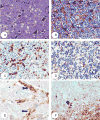Kuru: genes, cannibals and neuropathology
- PMID: 22249461
- PMCID: PMC5120877
- DOI: 10.1097/NEN.0b013e3182444efd
Kuru: genes, cannibals and neuropathology
Abstract
Kuru was the first human transmissible spongiform encephalopathy (TSE) or prion disease identified, occurring in the Fore linguistic group of Papua New Guinea. Kuru was a uniformly fatal cerebellar ataxic syndrome, usually followed by choreiform and athetoid movements. Kuru imposed a strong balancing selection on the Fore population, with individuals homozygous for the 129 Met allele of the gene (PRNP) encoding for prion protein (PrP) being the most susceptible. The decline in the incidence of kuru in the Fore has been attributed to the exhaustion of the susceptible genotype and ultimately by discontinuation of exposure via cannibalism. Neuropathologically, kuru-affected brains were characterized by widespread degeneration of neurons, astroglial and microglial proliferation, and the presence of amyloid plaques. These early findings have been confirmed and extended by recent immunohistochemical studies for the detection of the TSE-specific PrP (PrP). Confocal laser microscopy also showed the concentration of glial fibrillary acidic protein-positive astrocytic processes at the plaque periphery. The fine structure of plaques corresponds to that described earlier by light microscopy. The successful experimental transmission of kuru led to the awareness of its similarity to Creutzfeldt-Jakob disease and Gerstmann-Sträussler-Scheinker disease and formed a background against which the recent epidemics of iatrogenic and variant Creutzfeldt-Jakob disease could be studied.
Figures




Similar articles
-
Ultrastructural study of florid plaques in variant Creutzfeldt-Jakob disease: a comparison with amyloid plaques in kuru, sporadic Creutzfeldt-Jakob disease and Gerstmann-Sträussler-Scheinker disease.Neuropathol Appl Neurobiol. 2009 Feb;35(1):46-59. doi: 10.1111/j.1365-2990.2008.00959.x. Epub 2008 May 30. Neuropathol Appl Neurobiol. 2009. PMID: 18513219
-
Gerstmann-Sträussler-Scheinker syndrome,fatal familial insomnia, and kuru: a review of these less common human transmissible spongiform encephalopathies.J Clin Neurosci. 2001 Sep;8(5):387-97. doi: 10.1054/jocn.2001.0919. J Clin Neurosci. 2001. PMID: 11535002 Review.
-
[Creutzfeldt-Jakob disease and other human transmissible spongiform encephalopathies. Part II].Psychiatr Pol. 2004 Mar-Apr;38(2):297-309. Psychiatr Pol. 2004. PMID: 15307294 Review. Polish.
-
A special report I. Prion protein (PrP)--amyloid plaques in the transmissible spongiform encephalopathies, or prion diseases revisited.Folia Neuropathol. 2001;39(4):217-35. Folia Neuropathol. 2001. PMID: 11928893 Review.
-
Relationship of microglia and scrapie amyloid-immunoreactive plaques in kuru, Creutzfeldt-Jakob disease and Gerstmann-Sträussler syndrome.Acta Neuropathol. 1994;87(5):526-30. doi: 10.1007/BF00294180. Acta Neuropathol. 1994. PMID: 8059606
Cited by
-
Kuru, the First Human Prion Disease.Viruses. 2019 Mar 7;11(3):232. doi: 10.3390/v11030232. Viruses. 2019. PMID: 30866511 Free PMC article. Review.
-
Kuru Disease: Bridging the Gap Between Prion Biology and Human Health.Cureus. 2024 Jan 5;16(1):e51708. doi: 10.7759/cureus.51708. eCollection 2024 Jan. Cureus. 2024. PMID: 38313950 Free PMC article. Review.
-
A first morphological and electrophysiological characterization of Fañanas cells of the mouse cerebellum.J Physiol. 2025 Feb;603(4):855-871. doi: 10.1113/JP285949. Epub 2025 Jan 27. J Physiol. 2025. PMID: 39869051 Free PMC article.
-
Kuru: a journey back in time from papua new Guinea to the neanderthals' extinction.Pathogens. 2013 Jul 18;2(3):472-505. doi: 10.3390/pathogens2030472. Pathogens. 2013. PMID: 25437203 Free PMC article. Review.
-
Different Molecular Mechanisms Mediate Direct or Glia-Dependent Prion Protein Fragment 90-231 Neurotoxic Effects in Cerebellar Granule Neurons.Neurotox Res. 2017 Oct;32(3):381-397. doi: 10.1007/s12640-017-9749-2. Epub 2017 May 25. Neurotox Res. 2017. PMID: 28540665
References
-
- Gajdusek DC, Gibbs CJ, Alpers MP. Experimental transmission of a kuru-like syndrome to chimpanzees. Nature. 1966;209:794–96. - PubMed
-
- Gibbs CJ, Jr, Gajdusek DC, Asher DM, et al. Creutzfeldt-Jakob disease (spongiform encephalopathy): Transmission to chimpanzee. Science. 1968;161:388–89. - PubMed
-
- Gajdusek DC. Unconventional viruses and the origin and disappearance of kuru. Science. 1977;197:943–60. - PubMed
-
- Prusiner SB. Prions. In: Jörnvall H, editor. Nobel Lectures, Physiology or Medicine 1996–2000. Singapore: World Scientific Publishing Co; 2003.
-
- Wüthrich K. NMR studies of structure and function of biological macromolecules. In: Frängsmyr T, editor. Les Prix Nobel The Nobel Prizes 2002. Stockholm, Sweden: Nobel Foundation; 2003.
Publication types
MeSH terms
Substances
Grants and funding
LinkOut - more resources
Full Text Sources
Research Materials
Miscellaneous

